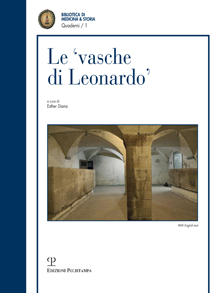Ricerca Veloce
Ricerca Avanzata
chiudi
Theories and truth behind the ‘Cisterns of Leonardo’ is the title of the first issue of a new series of ”Notebooks” directed by Enrico Ghidetti and Mark Geddes da Filicaia
Theories and truth behind the ‘Cisterns of Leonardo’ is the title of the first issue of a new series of ”Notebooks” directed by Enrico Ghidetti and Mark Geddes da Filicaia, as part of the ”Library of Medicine & History” published by Polistampa in Florence in 2016. This extended study undertaken within the TEMART project comprises the following main parts: 1. motivation and state of the art; 2. materials and methods; 3. results and discussion; 4. conclusions; 5. endnotes. Its scope and debates are presented in this brief monograph edited and co-authored by Esther Diana, head of the Documentation Center for the History of Welfare and Health in Florence and ISHM member. The multidisciplinary team of researchers also included Giulia Dionisio, Marielena Fedi, Lucia Caforio, Marco Giamello, Sonia Mugnaini, Salvatore Siano from: the University of Florence-Department of History, Archaeology, Geography, Arts, En-tertainment (SAGAS), and Department of Physics and Astronomy; the Florence National Research Council (CNR) - Department of Applied Physics; the National Insti-tute of Nuclear Physics (INFN) of Florence; the University of Siena - Department of Physical Sciences, Earth and Environment. Marco Geddes da Filicaia signed the fore-word. This investigation aimed at clarifying legends concerning the ‘Leonardo`s cisterns’ (le ‘vasche di Leonardo’), three large sandstone containers (VG, LX, IL) kept in the basement of the old Florentine Santa Maria Nuova Hospital, founded in 1285 by Folco Portinari, the father of Dante’s Beatrice. (Fig. 1) Supposedly, corpse dissections would have been performed in these stone containers by Leonardo da Vinci himself. Such stories probably arose from the documented historical fact that Leonardo really prac-tised about 30 anatomical autopsies of males and females of all ages, most of them at the Santa Maria Nuova Hospital during his stay in Florence between 1502-1508. Other artists did that, too. Four working hypotheses were considered, trying to explain the possible use of the cisterns as: 1. dyeing tubs; 2. food storage (wheat, flour, cereals, legumes); 3. storage of dead bodies (a quite frequent practice in European hospitals, with or without explicit consent of public authorities); 4. celebratory sarcophagi. Hospital archives and cisterns were thoroughly examined. Modern mineralogical and petrographic analyses of the tubs utilized stereomicroscopy, X ray diffraction, thin section study under polarized light microscope and scanning electron microscopy with energy dispersive spectroscopy (SEM-EDS) microprobe. Dating of vegetal material from the drain holes was achieved using the 14C method with Accelerator Mass Spectroscopy (AMS). Both radiocarbon age and calibrated age were calculated. The size of tubs LX and IL was comparable: 3,00-3,03 m length, 1,28 m width, 0,90 m height, 0,77 m internal depth, and 12 cm thickness; VG cistern was larger displaying 1,40 m length, 4,46 m width, 1,02 m height, 0,87 m internal depth, and 15 cm thickness; b). morphological and structural features of these single block gray sandstone tubs were similar, proving a common geographical origin. Assessment of residual materials, and organic vegetal fiber fragments identified in drain holes and different areas of the cisterns revealed their permeation with red pigments; the reddish colored substance corresponded to iron oxide of hematite type, a well known pigment used in painting and dyeing of textiles; c) the calibrated radiocarbon dating indicated a period between the 14th century and the first half of the 15th century, for vegetal fiber specimens in LX and IL cisterns; the VG vegetal fiber samples resulted to be younger, that is modern, generically expressing a period comprised between 1650- 1950. In conclusion, these findings together with complementary written documents see-mingly enforced the idea that the sandstone artifacts served as dyeing tubs for textiles. From documents belonging to the Hospital of Santa Maria Nuova dated between 1314 and 1960 no precise evidence emerged concerning the origin, date of acquisition, and function of these tanks over the centuries, but they did provide information partly confirming the complex analyses performed on the stone samples. The Hospital possessed indeed dyeing shops and buildings involved in the wool industry belonging to the Wool Guild. These circumstances associated with the red pigments and reddish colored vegetable fibers found at the level of the three cisterns support the conclusion that the tanks could have served as dyeing tubs for textiles. Dr. Esther Diana`s book does not confirm the hypothesis that these tanks would have ever been used to store and dissect corpses either by Leonardo or other persons, since reliable arguments are lacking: 1. available documents do not mention such details; 2. at that time a simple plank sufficed for anatomo-pathological dissections as depictions show; 3. both dimensions of the tubs and many other hygienic constraints would have also discouraged comparable activities in the basement of the Florentine Hospital. Undoubtedly, the ”mystery” surrounding these cisterns and rooms where they are to be found will continue to fascinate for a while, but the first step meant to elucidate the legend has already been taken and the first scientific phase successfully completed. This interesting research is synthesized in a clear, concise and accessible style, which undoubtedly enables its practical purpose. It also occasions a glimpse into life during the Renaissance in Florence along with the evocation of a piece of the history of the Hospital of Santa Maria Nuova - an authentic Museum today -, of its role in the development of arts and science.
Data recensione: 01/12/2016
Testata Giornalistica: Vesalius
Autore: Dana Baran
